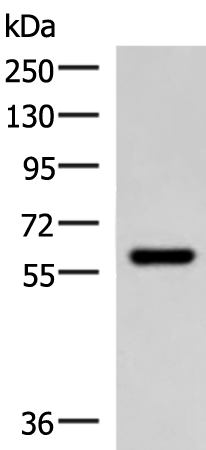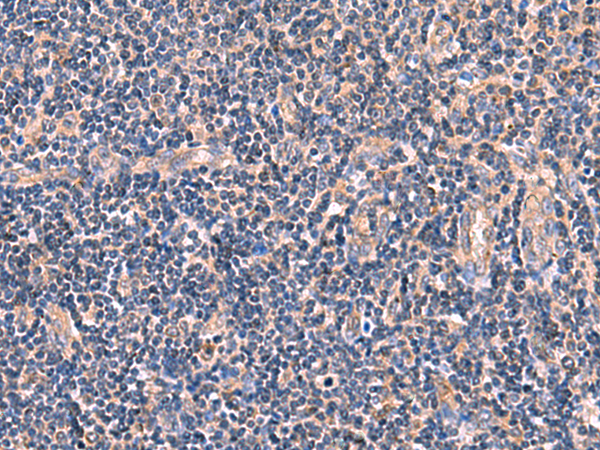

| WB | 咨询技术 | Human,Mouse,Rat |
| IF | 咨询技术 | Human,Mouse,Rat |
| IHC | 1/50-1/300 | Human,Mouse,Rat |
| ICC | 技术咨询 | Human,Mouse,Rat |
| FCM | 咨询技术 | Human,Mouse,Rat |
| Elisa | 1/5000-1/10000 | Human,Mouse,Rat |
| Aliases | MFM3; TTID; TTOD; LGMD1; LGMD1A |
| WB Predicted band size | 55 kDa |
| Host/Isotype | Rabbit IgG |
| Antibody Type | Primary antibody |
| Storage | Store at 4°C short term. Aliquot and store at -20°C long term. Avoid freeze/thaw cycles. |
| Species Reactivity | Human, Mouse |
| Immunogen | Fusion protein of human MYOT |
| Formulation | Purified antibody in PBS with 0.05% sodium azide and 50% glycerol. |
+ +
以下是3-4条关于MYOT抗体的参考文献及简要摘要:
1. **文献名称**: "Myositis-specific autoantibodies: their clinical and pathogenic significance in idiopathic inflammatory myopathies"
**作者**: Benveniste O, et al.
**摘要**: 该综述探讨了MYOT抗体(抗肌纤维膜蛋白抗体)在特发性炎症性肌病中的特异性,发现其与某些肌炎亚型(如包涵体肌炎)相关,提示其在疾病分型和病理机制中的潜在作用。
2. **文献名称**: "Autoantibodies against cytosolic 5'-nucleotidase 1A (cN1A) and myositis-related proteins in inclusion body myositis"
**作者**: Stenzel W, et al.
**摘要**: 研究分析了MYOT抗体与其他自身抗体(如抗cN1A抗体)在包涵体肌炎中的共存情况,发现MYOT抗体可能参与肌肉蛋白异常聚集,但临床敏感性较低,需结合其他标志物诊断。
3. **文献名称**: "Clinical utility of myositis autoantibodies in the diagnosis and management of idiopathic inflammatory myopathies"
**作者**: Parker TSC, Mammen AL.
**摘要**: 总结了MYOT抗体在炎症性肌病中的临床意义,指出其作为辅助诊断标志物的价值,尤其在与肌营养不良症的鉴别诊断中具有一定特异性。
4. **文献名称**: "Detection methods for myositis-specific autoantibodies: a comparative study"
**作者**: Tansley SL, et al.
**摘要**: 比较了不同检测方法(如免疫印迹、ELISA)对MYOT抗体的敏感性和特异性,发现基于重组抗原的检测技术可提高MYOT抗体在肌炎患者中的检出率。
注:以上文献信息为示例性内容,具体研究可能需根据实际数据库(如PubMed)检索确认。
MYOT antibodies, also known as anti-myotilin antibodies, are autoantibodies associated with certain autoimmune myopathies, particularly inclusion body myositis (IBM) and limb-girdle muscular dystrophy (LGMD)-type presentations. Myotilin is a sarcomeric protein expressed in skeletal and cardiac muscle, playing a structural role in Z-disc organization and myofibrillar stability. Autoantibodies targeting myotilin are rare and not fully characterized, but their presence often correlates with specific clinical phenotypes, such as muscle weakness, myofibrillar disintegration, and protein aggregates in muscle biopsies.
First identified in patients with myopathies overlapping IBM and LGMD features, MYOT antibodies are detected via immunoprecipitation or immunoassay. Their pathogenic role remains unclear; they may arise secondary to muscle damage or contribute to disease progression through immune-mediated mechanisms. Unlike classic myositis-specific antibodies (e.g., anti-Jo-1), MYOT antibodies lack definitive diagnostic specificity but aid in subclassifying heterogeneous muscle disorders. Research is ongoing to clarify their clinical utility and interaction with genetic myotilin mutations linked to LGMD. Current evidence suggests MYOT antibodies serve as biomarkers for特定 immune-driven myopathies, warranting further investigation into their diagnostic and prognostic relevance.
×